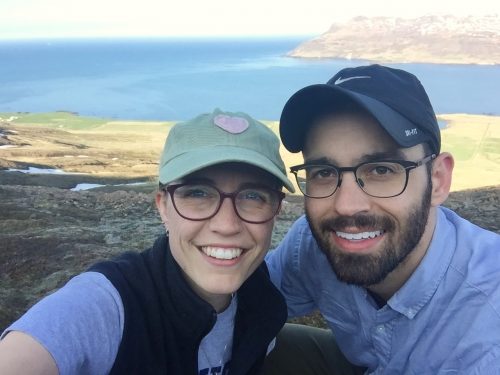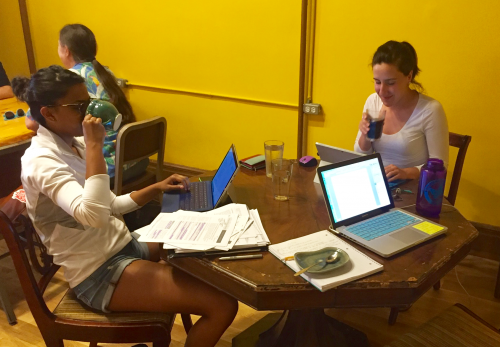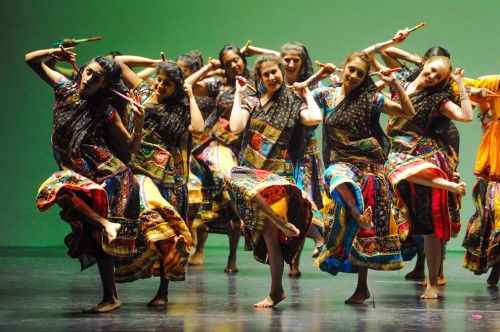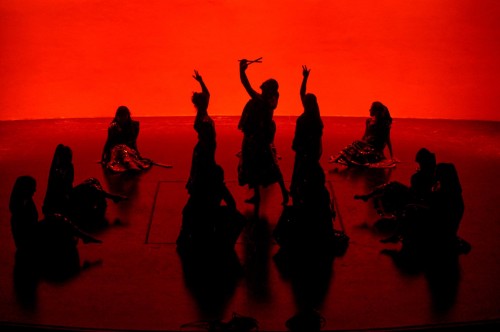by Kate | Jun 24, 2016
It’s summer for the new M2s!! Actually, this is old news. We took our last exam on May 15th and so we have enjoyed almost six weeks of break. Since we start class again on August 1st, we are almost exactly at the halfway point of our summer. Time is flying by, so I’m not going to think about that; instead I’ll focus on how wonderful these past 6 weeks have been.
A few days after the end of term I headed northeast…really northeast…all the way to Iceland! I traveled around the island hiking above fjords, ogling beautiful glacial waterfalls, waving at sheep, camping under the midnight sun, and forgetting that I was a medical student.

Hiking in Iceland! (Wearing my Michigan Med shirt, of course.)
I needed the break. I came back ready to get to work on my task for the summer: my SBRP project. The Student Biomedical Research Program (SBRP) is organized by the medical school, and provides a stipend for 10 weeks of research that medical students complete in partnership with a faculty member. I am working with Dr. Maggie Riley, a family medicine physician here at UM, to analyze the effectiveness of a program called MiHealth. MiHealth was designed by two M2s last year, and was piloted this spring. In the program, groups of medical students teach a series of health lessons in high school health classes, covering Smoking & Drugs, Mental Health & Depression, Healthy Relationships, Sexual Health, Nutrition, and Fitness & Exercise. The goals were to increase high school students’ health knowledge and reduce their risk behaviors, and to create a program that everyone involved (high school students and medical students) valuable. We gave everyone involved pre- and post-surveys to measure these metrics. I helped teach some of the lessons, and I certainly thought the program was valuable! It was great to get out into the community and interact with the high schoolers. By the time I finish my SBRP project we’ll know if the others involved agree with me. Stay tuned!

M2s working on research in a coffee shop.
My summer days have developed a rhythm: wake up early and go running, make breakfast and pack a lunch, walk downtown to work for a few hours in a coffee shop, change to a different coffee shop or the library after lunch and work some more, head home to relax or hang out with friends. After a year of keeping my nose to the grindstone for school, even working full time on a research project feels like a break. Having time to hang out with classmates without having to study at the same time feels particularly novel and fun. We’re working hard at completing the “summer in Ann Arbor bucket list,” which includes things like going to free concerts at the Summer Festival, tubing down the river, trying new restaurants during Restaurant Week, drinking sangria at Dominick’s, watching Shakespeare in the Arb, and walking the streets during the Ann Arbor Art Fair.
I’ve had time to read as well, which is great! My favorite book for this summer so far has been The Ghost Map, by Steven Johnson. It tells the story of the 1854 London cholera outbreak that, through a groundbreaking epidemiological study, resulted in the discovery that water coming from the Broad Street pump was the source of the bacteria, advancing public health, epidemiology, and bacteriology. Johnson writes a great narrative and incorporates aspects of sociology and urban history as well. I definitely recommend it.
A parting word of advice, if you are attending medical school in the fall, relax and soak up as much sun as you can now! I know I am.
Kate is a third-year medical student at University of Michigan Medical School. She is passionate about women’s health, reproductive justice, and finding the humanities in medicine. When not in the hospital, you’ll probably find her running along the Huron River or puzzling over the NYTimes Sunday crossword.
by Kate | Jan 27, 2016
Wow! It has been a while since I last posted. If there is one thing I know for sure about medical school, it’s that it makes time disappear. One day it’s August and you’re trying on your white coat for the first time and then BLINK it’s October and you’ve just finished examining your first standardized patient on your own and BLINK you’re finished with one semester of medical school and charging head first into your second.
As fast as it sometimes seems, med school is truly a marathon; there are miles and miles to cover every day and slowing down means risking falling terribly behind. Stopping isn’t an option. There are some downhills and many challenging uphills. The marathon of medical school is one of the hardest things I have ever attempted to do. But amongst the challenges, there are days when the path crests a hill. On those wonderful days something clicks; another piece in the huge jigsaw puzzle I am scrambling to assemble falls into place. On those days I can see the finish line in the distance.
A Thursday late last fall was one of those days. Every other Thursday I have ICE (the Initial Clinical Experience), the class in which we shadow different members of the healthcare team. On this particular Thursday, I was assigned to work with a dietician in the pediatric cystic fibrosis clinic. We had covered the molecular basis for CF (mutation in a chloride channel called CFTR) and its many clinical effects in lecture several weeks before, so I was able to have a meaningful conversation with the dietician about CF and her role in keeping her patients healthy. We were in the midst of our respiratory unit, so when I watched the respiratory therapist run pulmonary function tests I could follow what he was doing. And because I understood the disease process going on in each microscopic cell of the patients’ bodies, when I looked at all the cells put together and saw happy and healthy kids, laughing with their care providers and talking about their new soccer team or their favorite subjects at school, I understood the magnitude of difference science, knowledge, and compassion – the things I learn about every day – can make in a person’s life. I was reminded that we are trying to do is important and worth it. It will make a difference.
But “crest days” don’t happen quite often enough to keep things comfortable, and I’ve found that it is important to bridge the gaps by finding a bit of balance in every day – even if it is just making sure to go for a run, or squeezing out an hour for dance practice. I have never been a dancer, but when the call went out to participate in Biorhythms, the biannual medical student dance show, I signed up! Biorhythms is directed, choreographed, and performed by medical students, and is one of the most anticipated traditions each year. I joined the dance called Dandiya Raas, a traditional dance from Northern India. Once a week beginning in September we got together to practice, laugh and forget about med school. At long last, performance day arrived in mid-January and it was time to put on our amazing costumes and perform!

Raas! I am on the far right, having a blast.
Our Raas performance went without a hitch – the audience loved it. I almost liked watching the other acts more than performing my own, because I was so impressed by my classmates’ performances, which included tango, Brazilian dance, hip-hop, jazz, and even med school-themed rap and a (PG13) finale called Mance. Biorhythms made for a wonderful evening! I am so glad I joined Raas because I learned an awesome, fast paced new dance, got to know some of the M2s, and got a weekly guaranteed study break.

A Raas Sunrise
Cheesy as it may be to say, as I start my second semester at UMMS I am finding my beat, both in class and out. Maybe even dancing to it!
Kate is a third-year medical student at University of Michigan Medical School. She is passionate about women’s health, reproductive justice, and finding the humanities in medicine. When not in the hospital, you’ll probably find her running along the Huron River or puzzling over the NYTimes Sunday crossword.
by Kate | Nov 1, 2015
Happy Halloween! Living up to tradition, Phi Rho (our medical student co-ed fraternity) hosted a Halloween bash and I was very impressed with my classmates’ costumes. As an ode to Dr. D’Alecy, the head of our cardiorespiratory sequence, Lauren and I went as his lecture slides:

M1s dressed as scary lecture slides
Below, I write about a recent seminar hosted by the Health Equity Scholars Program (HESP), a med student organization focused on learning about health disparities and on community service.
~
“I feel so sorry for people not living in Detroit!” This provocative statement opens the documentary, American Revolutionary, which explores the life of Detroit activist and revolutionary Grace Lee Boggs. Her simple statement set the stage for a 90-minute seminar, “Learning from History: Grace Lee Boggs and the Competing Narratives of Detroit’s Past, Present, and Future,” presented by UM Professor Stephen Ward, and hosted by HESP. The class was thought provoking, energizing, and one of the best I have attended at UMMS.
Professor Ward challenged our group of M1s and M2s to consider differing narratives of Detroit’s history: a “rise and fall” narrative in which Detroit rose to greatness, fell to despair, and may be beginning to experience a comeback; and a “communities” narrative, in which Detroit’s many communities have continuously evolved and changed over time, each encountering moments of prosperity and hardship. “Which narrative empowers Detroit’s citizens?” asked Professor Ward, “Does one narrative diminish people’s continuous presence and their work for positive change? What does the phrase, ‘making a comeback,’ imply about Detroit’s past and its current direction?” The discussion flowed. The comeback phrase was explored extensively. Professor Ward presented us with Boggs’s view, that social change – or “revolution,” as she called it – comes from constant evolution in the face of challenges. In her eyes, challenges arise continuously, and only innovative solutions to these challenges will propel us to a better state of being. This process, repeated over and over, is her revolution. Boggs saw Detroit as an opportunity for societal growth without repeating our unsuccessful history – as a place ripe for revolution.
At the end of the seminar, the conversation turned to medicine and we considered our roles as future physicians in Detroit and the world at large. Professor Ward challenged us to apply Boggs’s model of revolution to medicine, to think beyond fixing the problems in front of our noses and to imagine our ideal healthcare system on the broadest level. “What does that healthcare system look like? What does care in that system entail?” I began to imagine clinics connected to community centers, fresh-produce grocery stores, and exercise centers; co-op healthcare systems; prescriptions for college education; smart phone patient check-ins; and a different payment system, yet unformed in my mind but tantalizing in its possibilities. Revisiting a theme encountered many times at Michigan, we reflected that to be a leader does not necessarily mean to stand in front of the multitudes, but rather to exemplify change. Ultimately we will all lead, and we must each determine what that will mean for each of us in our own context. At the seminar, we considered the possibilities of where our leadership could take us and our communities.
In medical school it is easy to get lost in the minutia and focus so much on physiologic problems and their pharmacologic remedies that I forget to consider issues in our healthcare system and the remedies these complexities demand. I am glad to participate in HESP, where I have found a community of diverse, thoughtful, and talented classmates who push me to consider these larger issues. And I am grateful to Professor Ward for challenging us to analyze our thought patterns, rethink our beliefs, and engage our imaginations to envision the healthcare system of tomorrow!
Kate is a third-year medical student at University of Michigan Medical School. She is passionate about women’s health, reproductive justice, and finding the humanities in medicine. When not in the hospital, you’ll probably find her running along the Huron River or puzzling over the NYTimes Sunday crossword.
by Kate | Sep 26, 2015
Close to two months of my first year of medical school have passed, and I finally feel as though I am getting my feet under me. UMMS has certainly been a whirlwind so far! Here’s a quick introduction to who I am: I grew up in a small town called Manchester, MI, and attended undergrad at Juniata College, studying biology and Spanish. After graduating in 2014, I worked as a research assistant with a pediatric nephrologist at the University of Iowa, then started at UMMS this fall. Today I’ll write about the Initial Clinical Experience, a new curricular component here at UM in which M1s shadow different members of the care team. It’s been one of my favorite things so far because I enjoy being in the clinic and I am learning a lot about what different health workers do.
On Thursday, I shadowed a respiratory therapist (RT) in the neonatal intensive care unit (NICU). I have previously shadowed physicians in the NICU, and so I was looking forward to returning to a familiar environment while seeing it from a different point of view. The RT I followed (I’ll call her Jen), seemed concerned that she didn’t have enough of interest to show me, but she needn’t have worried. I spent much of the afternoon trying to understand the many types of respiratory support available and when each would be favored (I was only partially successful on this front!). Jen showed me jets, oscillators, traditional vents, and a seemingly huge number of different CPAP set-ups. But more impressive than her knowledge of the many machines was the realization that she, like most RTs, was trained to work with both adult and pediatric populations, and that a pediatric RT like Jen rotates through an incredibly diverse array of patients (at UM all the Mott RTs rotate through the NICU, PICU, and pediatric cardiology units). That the RTs can switch between these different patient populations is impressive.
As I watched Jen, the lines between work assigned to the nurses, the RTs, and the physicians, at first blurry, slowly came into focus. And as equally spaced and balanced as these lines seemed to be, I also clearly saw the manifestation of a hierarchal division of power and ultimate responsibility. At one point, Jen and another RT were working together to deliver a dose of surfactant (a lung lubricant) to a tiny 2-day-old patient. The dose, a liquid suspension injected into the lung, was given, and the patient’s oxygen saturation began to fall: 85…75…65…55…45… With every drop in saturation, the tension in the room rose. The RTs changed the vent settings to optimize oxygenation, to no avail. By the time he had reached the low 30s, the RTs had punched the ‘staff assist’ button and the fellow physician had come running, clearly stepping into the directing role. It was she who rechecked the RTs’ vent settings, assessed the patient, and who ultimately would have made the call had more drastic action been needed. This time, the patient’s O2 sats finally trickled up to a comfortable 95% with no further intervention, but I was left wondering about the emotional dynamics of the situation. Were the RTs thankful that ultimate responsibility was not expected to rest on their shoulders, or were they sometimes resentful, feeling that they had more depth of respiratory care knowledge? And how would it feel, how will I feel, to be the fellow physician in that moment, knowing that I am responsible for confidently and expertly handling such critical situations? I certainly don’t feel prepared now, but with the amount I am learning every week, I know I’ll be ready one day. And if time keeps up its current break-neck pace, that day will be here before I know it.
Kate is a third-year medical student at University of Michigan Medical School. She is passionate about women’s health, reproductive justice, and finding the humanities in medicine. When not in the hospital, you’ll probably find her running along the Huron River or puzzling over the NYTimes Sunday crossword.





